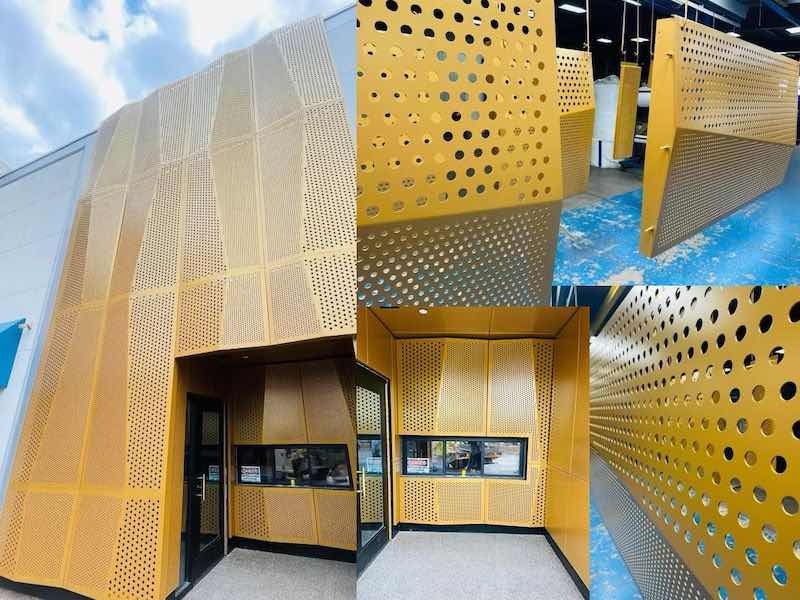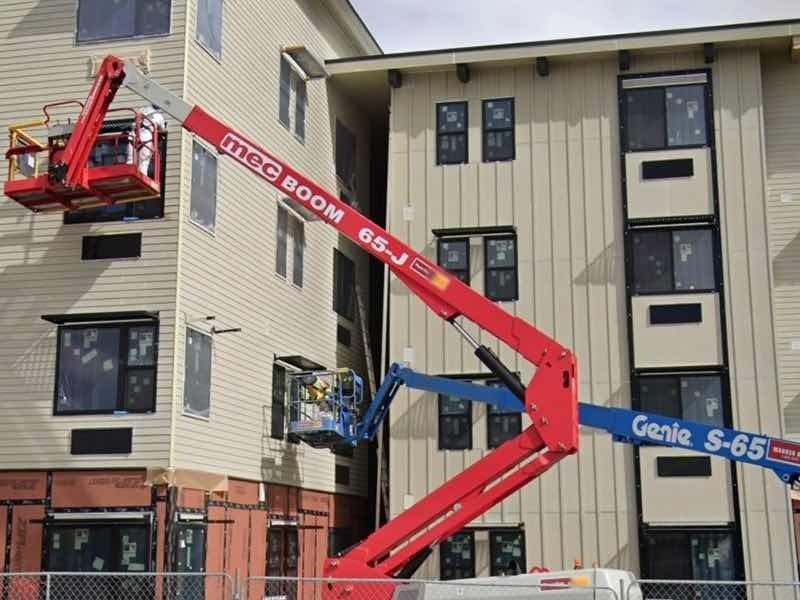Talk to anyone in the performance coatings industry in North America, and they will probably start talking about the AAMA specs pretty quickly.
 Fiona Levin-SmithWhat are they, and why do coatings experts talk about it so much?
Fiona Levin-SmithWhat are they, and why do coatings experts talk about it so much?
Originally, AAMA was an acronym for the American Architectural Manufacturers Association. The association changed its name a few years ago – it’s now the FGIA: Fenestration and Glazing Industry Alliance.
They created a whole variety of voluntary specifications – testing and performance requirements - for many different aspects of the architectural manufacturing world. They kept the name of their specifications as the AAMA specs as they are so widely used.
Three Specifications for the Coatings Industry
 This storefront features IFS 400SD in Gold Nugget and was coated by A Plus Powder Coating in Columbiana, OHThere are three specifications that apply to the coatings industry: AAMA 2603, AAMA 2604, and AAMA 2605.
This storefront features IFS 400SD in Gold Nugget and was coated by A Plus Powder Coating in Columbiana, OHThere are three specifications that apply to the coatings industry: AAMA 2603, AAMA 2604, and AAMA 2605.
It’s probably important to point out here that these three coatings specs are for all coatings. For many years, liquid coatings have talked about the AAMA coating specs, and so people often incorrectly associate them with liquid coatings only. In fact, they are for all high-performance coatings, and so they apply to both liquid (think liquid PVDF paint) and superior-performance architectural grade powders (think FEVE Fluoropolymers).
Anodized is not included in these particular specifications, as anodizing actually changes the substrate itself, so it is referred to as a ‘finish,’ and there are separate AAMA specifications for anodizing (e.g., AAMA 611).
So what are these specifications all about, and why are they important to both coaters and the design community?
Measurement of Performance Capability of Coatings
Simply put, they will give you a very good idea of the performance capability of the coating. Each spec requires a certain number of chemical, mechanical, and weathering tests to be performed and lays out minimum performance requirements for each.
As you move up through the coating specifications, the tests become longer and stricter.
So, what type of tests are we talking about? Some of the most important tests AAMA requires are in the below table. There are actually around 20 tests in total, but these are some of the most telling.
Check out the test and how it varies between the various AAMA specifications.
| AAMA 2603 | AAMA 2604 | AAMA 2605 | |
| Chemical resistance | Same | ||
| Humidity resistance (ASTM D2247 or ASTM D4585/4585M) | 1500 hrs; Few blisters | 3000 hrs; Blisters size 8 | 4000hrs; Blisters size 8 |
| Salt spray resistance (ASTM G85) | 1000 hrs; 1-2mm creepage; Blisters size 8 | 1500 hrs; 1-2mm creepage; Blisters size 8 | 2000 hrs; 1-2mm creepage; Blisters size 8 |
| Florida Exposure | 1 year | 5 years | 10 years |
| Color retention | “Slight change” | Delta E <5 | Delta E <5 |
| Gloss retention | “Slight change” | Minimum 30% | Minimum 50% |
As you can see, as you move up through the specifications, tests like corrosion and weathering require more and more from the coating.
So, which powder products will meet these coating specifications?
Making sure you get the right product performance for your application is important. Here’s what you should expect.
AAMA 2603
 Architectural powders provide protection and gorgeous colors and effects to everything from skyscrapers to storefront. This Stiffkey Blue is a custom IFS color created for Provisions Bakery and Cafe. Credit to Karli M Photography.IFS 300SP is the IFS Standard Polyester that will meet and exceed the performance requirements of AAMA 2603. As the weathering requirements of AAMA 2603 allow a “slight change” in the color and gloss (not very specific.), we normally recommend these powders for interior uses where weathering or exterior conditions are not really a factor. They do sometimes get used on the exteriors of low-value residential projects – items like windows, fixtures, fittings, etc. – but for general purposes, regard them as a good all-round interior grade powder.
Architectural powders provide protection and gorgeous colors and effects to everything from skyscrapers to storefront. This Stiffkey Blue is a custom IFS color created for Provisions Bakery and Cafe. Credit to Karli M Photography.IFS 300SP is the IFS Standard Polyester that will meet and exceed the performance requirements of AAMA 2603. As the weathering requirements of AAMA 2603 allow a “slight change” in the color and gloss (not very specific.), we normally recommend these powders for interior uses where weathering or exterior conditions are not really a factor. They do sometimes get used on the exteriors of low-value residential projects – items like windows, fixtures, fittings, etc. – but for general purposes, regard them as a good all-round interior grade powder.
AAMA 2604
IFS 400SD is the IFS Super Durable Polyester that will meet and exceed the performance requirements of AAMA 2604. The testing requirements, including weathering, are much stricter than the 2603 requirements, with exact performance parameters (as you can see, the weathering requirement is five times that of the standard polyester). For this reason, super durables are regarded as good exterior grade powders that are often used on windows, doors, and especially on applications like commercial storefronts. Super durables come with a 10-year warranty when applied by a registered applicator to aluminum – great for storefronts where the chance of the same store being in place in 20 years is unsure, but a robust 10-year performance is ideal.
AAMA 2605
 This building benefits from sunshades above the windows coated with beautiful, durable Fluoropolymer powder, applied by Registered Applicator Maas Brothers. IFS 500FP is the IFS FEVE-based Fluoropolymer that will meet and exceed the performance requirements of AAMA 2605. The testing requirements are stricter than the 2604 performance requirements, with weathering testing being double that of the 2604 spec. For this reason, Fluoropolymers are regarded as an excellent high-performance exterior grade powder. They are almost always used solely on exterior applications and are used on curtain walls and façades, windows, doors, etc., on monumental buildings, high-value residential, stadiums, malls, hospitals, government buildings, and more. Fluoropolymers come with a 20-year warranty when applied by a registered applicator to aluminum. If you want a liquid comparison – think 70% PVDF paint. Most powder manufacturers require you to be a registered applicator to buy and apply fluoropolymer powder.
This building benefits from sunshades above the windows coated with beautiful, durable Fluoropolymer powder, applied by Registered Applicator Maas Brothers. IFS 500FP is the IFS FEVE-based Fluoropolymer that will meet and exceed the performance requirements of AAMA 2605. The testing requirements are stricter than the 2604 performance requirements, with weathering testing being double that of the 2604 spec. For this reason, Fluoropolymers are regarded as an excellent high-performance exterior grade powder. They are almost always used solely on exterior applications and are used on curtain walls and façades, windows, doors, etc., on monumental buildings, high-value residential, stadiums, malls, hospitals, government buildings, and more. Fluoropolymers come with a 20-year warranty when applied by a registered applicator to aluminum. If you want a liquid comparison – think 70% PVDF paint. Most powder manufacturers require you to be a registered applicator to buy and apply fluoropolymer powder.
In actual fact, the AAMA specifications are a great way to specify any performance coating – no matter whether it’s powder or liquid; stating the AAMA spec level gives you an absolute minimum that must be met and stops a contractor from simply getting any “powder coating” or “paint” in the right color, regardless of performance.
For more information, talk to your IFS architectural coatings rep: coatingsinfo@ifscoatings.com
Fiona Levin-Smith is Vice president of Marketing and Specification for IFS Coatings. For further questions or inquiries, visit www.ifscoatings.com



































